What is good about this building:
By accident this building is passive solar. All the glass faces 20 degrees within south.
The awning keeps the sun off the glass during the summer.
But when the sun is much lower in the winter, plenty of sunshine comes in the glass,
greatly reducing winter heating costs.
A steep bank behind the store shields the cold winter winds from the building.
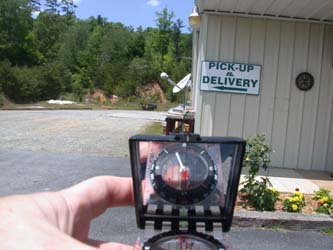
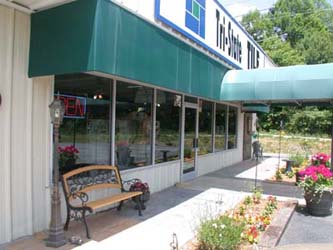
What can be done to make this building much more comfortable and energy efficient:
In my opinion, the greatest improvement can be made by increasing the ceiling insulation.
The existing insulation is typical metal building roof batts, squeezed between the metal structures of the roof.
Where the insulation is thickest, it might be R11,
but every 36" this insulation is pinched between the metal framing, reducing its value to almost nothing.
The minimum insulation required by code is R-38 in our area, and I recommend that more insulation be added to meet this code.
This may be done by removing the false wood beams,
installing light gauge metal firring channels across the bottom of the metal roof beams,
rewiring the ceiling lighting and fans at this level,
and closing up the ceiling with 5/8" sheetrock.
Not only would this improve the energy efficiency and comfort, but it would open up the ceiling of this showroom,
making it look more professional and inviting.
The existing wood framework is sagging, difficult to clean, and doesn't look very good.
After this is done, new exposed ductwork can be hung from the ceiling.
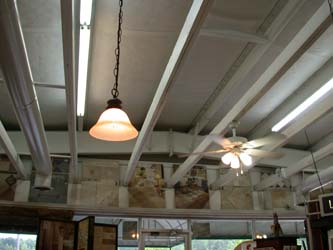
The next item for improvement is the ductwork. I don't feel comfortable criticizing someone else's work, but the ductwork in this building was very poorly designed and installed. On a positive note, the majority of the ductwork is inside the air conditioned area. (Ductwork in the attic would get hot or cold, making the system work much harder to keep the building comfortable. But the other half of the ductwork is in the hot attic. So is the air conditioner. The poor unit is running all day long, non stop, trying to overcome the attic heat in order to cool the building. But there is another serious problem. Look at how badly pinched the ductwork is in the photos below. What happens to the water coming out of the garden hose when it is pinched like that? The same thing happens to the cold air. It doesn't blow into the offices below. This ductwork probably leaks too. I did not see any mastic painted on the ductwork. Tape alone is not good enough. So I recommend the ductwork be replaced, and the air conditioner be placed inside an air conditioned area, insulated from the hot attic air. The air conditioner will run much less and last much longer. I also recommend that the entire duct system be brought inside the air conditioned area. These changes should reduce the air conditioning costs a lot.
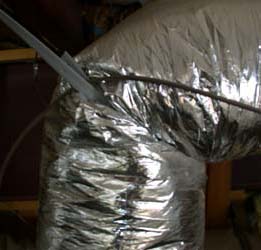
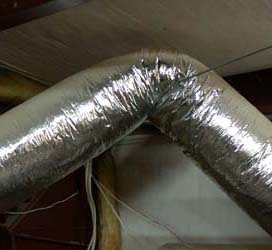
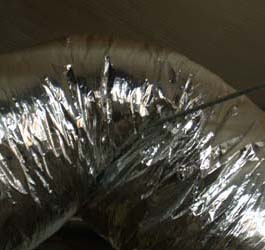
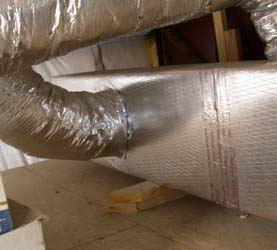
While doing this, I recommend that the bathrooms be separated from the air conditioning system. When I inspected the building, the air conditioning had been running continuously for hours, and the air coming out of the registers in the bathroom was warm. The long skinny flex duct (shown in the photo below) restricts the airflow, letting the heat surrounding the duct heat up the duct. Another problem is the poor insulation workmanship on the bathrooms. Fiberglass insulation is worthless if there are any gaps for air to leak through. In one place I checked, I found a 2" wide gap. Because these bathrooms are so far from the rest of the air conditioned area, I don't believe it would be worthwhile to use one system for both areas. If the bathrooms were not air conditioned at all, they would be no less comfortable than they are right now. If they decide the bathrooms must be air conditioned, I recommend a small, separate system.
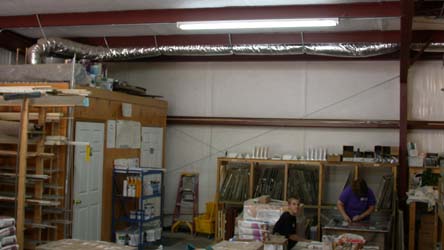
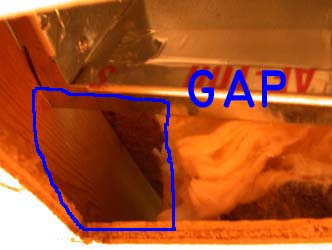
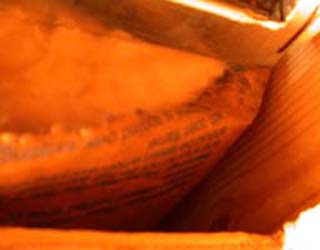
The next area to consider is the air conditioner. I spoke with the factory, and they told me this system has a SEER rating of about 10. This is far below the minimum required by code. The unit is so inefficient that if they borrowed money to upgrade it, they would probabley save more money in electricity than they would spend on the new payment. For example, if they replaced this sytem with a 15 SEER unit, they would reduce their air conditioning costs by 1/3. I recommend that they talk to the electricity company about any programs they have available for upgrading the air conditioner. If they qualify for one of these programs, the electric company will require that the work be inspected before they approve it. For a new enery efficient air conditioner to perform well it must be installed correctly.
The next area to consider is the lighting. A few of the bulbs had been replaced with fluorescent lamps. But I still counted 42 incandescent bulbs that are running all day, and 8 more in the bathroom. If these run all day long, they probably burn about 90 kwhours per month. Replacing them could reduce their lighting costs by $12 per month. But that is not all. The reason incandescent bulbs use more electricity is that much of the energy is wasted making heat. That heat adds to the problem in this building, making it harder for the air conditioner to keep up.
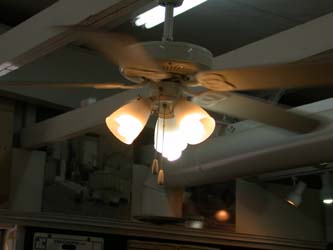
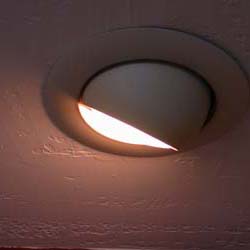
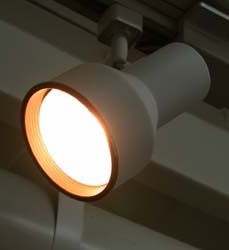
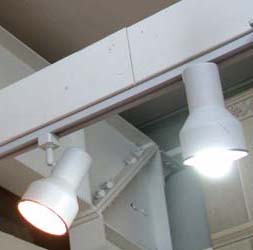
The last area to consider is landscaping. If they would plant some deciduous trees (those that lose their leaves in the fall) on the west and east side of the building, they would keep a lot of hot summer sun off the building. These trees don't have to be right next to the building, just close enough to add some shade in the future. This would also frame in the front view of the building, making it more attractive to their clients.
How to Contact Richard C. MacCrea
 My Facebook Page
My Facebook Page(Design news and ideas)
Email Me
(Opens an email window)
800.738.8781 P.O. Box 446, Murphy, North Carolina 28906
Other Pages on this Web Site
 The Mountain Home Show, Home Page and Site Map
The Mountain Home Show, Home Page and Site Map(How to find what you're looking for)
The Next Mountain Home Show Program
(For guests and exhibitors)
How to Get in The Mountain Home Show
(For exhibitors)
Articles
(About designing, building and remodeling a mountain home)
The Mountain Model Home
(A home that experiments with extreme energy efficiency)
The Mountain Model Cabin
(A cabin that experiments with small size and energy efficiency)
Construction Diary
(The joys and frustrations of building these two model homes)
Home Designing and Planning
(How to get plans for building or remodeling your home)
How to Contact The Mountain Home Show
Appreciation......
This web site contains information obtained from various sources.
The Mountain Home Show is not liable for the accuracy of this information.
Please contact the source of this information with your questions.
 Email Us
Email Us
(Opens an email window)
Like our Facebook Page
(Join our Mountain Home Show Community for news and contacts)
The Mountain Home Show, P.O. Box 446, Murphy, North Carolina 28906-0446
The Mountain Home Show owes its success to the businesses that participate in the show.
They arrange such wonderful exhibits.
It is obvious that they take great pride in their work and our show.